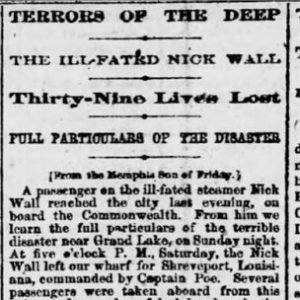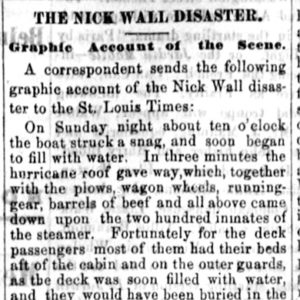calsfoundation@cals.org
Nick Wall [Steamboat]
The Nick Wall was a sternwheel river packet that struck a snag on the Mississippi River near Grand Lake (Chicot County) on December 18, 1870. At least thirty-nine passengers and crew members died in the accident.
The Nick Wall, named for a noteworthy Missouri River riverboat captain, was a 338-ton sternwheel paddleboat built in 1869 in Pittsburgh, Pennsylvania. The vessel was heading from St. Louis to Fort Benton, Montana, on the Missouri River when it struck a snag near Brownville, Nebraska, in March 1869 and sank. The steamboat was reportedly “raised by Submarine No. 14” in May and sent to St. Louis for repairs, which were completed in June.
Thomas Poe of Georgetown, Pennsylvania, bought a half interest in the Nick Wall in early 1870; the remainder was owned by the Carter Line Packet Company. Poe was serving as its captain when the steamboat was on a run from St. Louis to New Orleans, carrying fifteen cabin and 125 deck passengers, many of whom were emigrants with their wagons and supplies aboard. They were near the community of Grand Lake (situated on an oxbow lake of the same name) when a stiff wind caused the vessel to strike a snag at about 9:00 p.m. on December 18, 1870.
The snag pierced the Nick Wall’s hull. The roof of the vessel’s hurricane deck, burdened with forty emigrant wagons and 900 barrels of beef, collapsed, trapping many people as the Wall drifted down the Mississippi. Passengers panicked as the boat filled with water, with one man stating that “men, women and children ran here and there, praying, cursing, screaming, crying for help among the utmost confusion. Everyone seems to have despaired of life, and terror seemed to reign in every heart.” A newlywed couple from Memphis and the bride’s parents were among those who died in the disaster.
The steamboat Seminole came across the stricken Nick Wall and attached a cable to it, towing the steamboat to a sandbar even as planks were laid between the ships to allow passengers and crew to escape the Wall. Many people jumped overboard, with some swimming 200 yards to shore and others perishing in the attempt.
Poe realized that his wife, Martha Jane Poe, was still in her cabin belowdecks and began furiously chopping the floor with an axe to try to reach her. He succeeded in chopping through the deck but accidentally cut her head with the axe as he penetrated the wood. Mark Twain wrote of the incident in Life on the Mississippi, stating that the steamboat “sank with astonishing suddenness; water was already well above the cabin floor when the captain got aft. So he cut into his wife’s stateroom from above with an axe; …the roof a flimsier one than he supposed; the first blow crashed down through the rotten boards and clove her skull.” Although initial reports stated that it was hoped that she would recover from the wound, she lived just a few days and died on December 22, 1870; she was buried in Georgetown, Pennsylvania.
The Nick Wall was valued at between $22,000 and $25,000 and insured for $15,000. Both the vessel and most of the cargo was lost. At least thirty-nine and as many as seventy people died in the disaster. This time, the steamboat was not salvaged but instead abandoned. Captain Poe, however, was not finished with the Nick Wall. About ten months after the accident, he was commanding the steamboat Mary E. Poe when it sustained a mechanical failure. A newspaper reported that “the Mary Poe stopped at the wreck of the Nick Wall; Capt. Poe went into it, took out the cylinder, and put it on the Poe in place of that boat’s broken cylinder.” The Mary E. Poe would itself fall victim to a river disaster, catching fire and burning on the Mississippi River at the Canadian Reach near Osceola (Mississippi County) in 1873 around the same place where the steamboat Car of Commerce was destroyed in 1828.
The Nick Wall disaster illustrates the dangers of nineteenth-century river travel in the waters around Arkansas, where collisions with snags also brought destruction to the Belle Zane in 1845 and the Mercury in 1867.
For additional information:
“Casualties.” Missouri Republican [St. Louis], December 22, 1870, p. 3.
“Loss of the Steamers ‘Nick Wall’ and ‘Glendale.’” Cairo [Illinois] Bulletin, December 23, 1870, p. 3.
“Missouri.” New York Daily Herald, May 3, 1869, p. 7.
“The Nick Wall Disaster.” Memphis Public Ledger, December 30, 1870, p. 1.
“River News.” Pittsburgh Weekly Gazette, June 10, 1869, p. 3.
“River News.” Pittsburgh Weekly Gazette, October 14, 1871, p. 3.
“River News.” Wheeling [West Virginia] Daily Register, June 1, 1869, p. 3.
“Terrors of the Deep.” New Orleans Republican, December 25, 1870, p. 1.
Twain, Mark. Life on the Mississippi in Mark Twain Mississippi Writings. New York: Literary Classics of the United States, Inc., 1982.
Way, Frederick, Jr. Way’s Packet Directory. Athens: Ohio University Press, 1983.
Mark K. Christ
Central Arkansas Library System
 Civil War through Reconstruction, 1861 through 1874
Civil War through Reconstruction, 1861 through 1874 Transportation
Transportation Nick Wall Steamboat Article
Nick Wall Steamboat Article  Nick Wall Steamboat Article
Nick Wall Steamboat Article 




Comments
No comments on this entry yet.